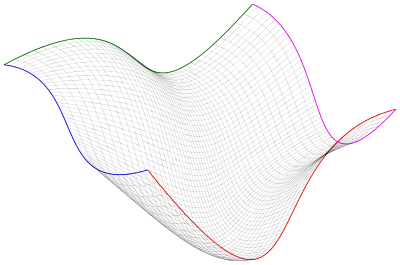Coons patch
In mathematics, a Coons patch, is a type of manifold parametrization used in computer graphics to smoothly join other surfaces together, and in computational mechanics applications, particularly in finite element method and boundary element method, to mesh problem domains into elements.

Coons patches are named after Steven Anson Coons, and date to 1967.[1]
Bilinear blending
Given four space curves c0(s), c1(s), d0(t), d1(t) which meet at four corners c0(0) = d0(0), c0(1) = d1(0), c1(0) = d0(1), c1(1) = d1(1); linear interpolation can be used to interpolate between c0 and c1, that is
and between d0, d1
producing two ruled surfaces defined on the unit square.
The bilinear interpolation on the four corner points is another surface
A bilinearly blended Coons patch is the surface
Bicubic blending
Although the bilinear Coons patch exactly meets its four boundary curves, it does not necessarily have the same tangent plane at those curves as the surfaces to be joined, leading to creases in the joined surface along those curves. To fix this problem, the linear interpolation can be replaced with cubic Hermite splines with the weights chosen to match the partial derivatives at the corners. This forms a bicubically blended Coons patch.
See also
References
- Steven A. Coons, Surfaces for computer-aided design of space forms, Technical Report MAC-TR-41, Project MAC, MIT, June 1967.
- Weiqing Gu. "Surface Construction Schemes". Retrieved 8 April 2012.